| JAVA STEAM BY DAY AND NIGHT One of the inspirations for visiting Java was provided by some Colin Garratt photographs which appeared in a book which I was given many years ago. These included a series of images of Javanese locomotives taken at night with vast trails of sparks emitting from the chimneys. The effects are extremely dramatic and are caused by locomotives burning bagasse. Because the bagasse is so fibrous a considerable amount passes through the firebox and along the boiler tubes without being fully burned until it is ejected from the chimney where it catches light. In daylight hours this process goes largely unnoticed except for the tiny pinprick holes which appear in your t-shirt as the sparks land on your clothing! At night however it is a different story! All that is required is for the crew to add some more bagasse bales to the fire or turn on the blower and suddenly the sky erupts into a spectacular firework display! For the price of a local packet of cigarettes such moments can be had to order, thus removing the unpredicable nature of such proceedings. |
| Merican (25) I had been advised that Merican was one of the best mills at which to observe the night time fireworks display. The mill always seems to have plentiful supplies of bagasse and c^opertive emngine crews. Spending the early hours of the morning enjoying the sunrise at Mount Bromo and then travelling to Merican by bus meant that I turned up at the gates fairly late in the afternoon and so didn't really have enough time to enjoy the mill in daylight hours. The situation was further complicated by the fact that the office staff who would have normally issued my mill permit had already gone home and the security guards took some time to find a way of extracting my fee and issuing the necessary paperwork. By late afternoon the main yard was full of loaded cane wagons and most locomotives were sitting patiently in the road delivery yard awaiting their turn to move their trains. With lengthening shadows it was only really possible to get half-decent shots of the engines in their red and yellow livery before waiting for the sun to set and the show to begin. (Left) The shadows of the fence are already beginning to obscure Orensteain and Koppel 0-8-0T No.8 (built 1927) as it waits in the road delivery yard |
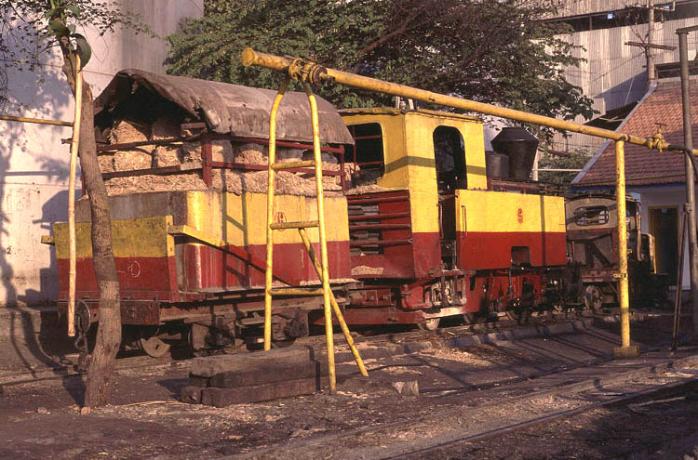
| Another centenarian still at work is this Orenstein and Koppel 0-4-2T No.6 (built 1901) seen standing outside the shed. The late afternoon sun highlights the attractive red and yellow livery worn by these engines. |
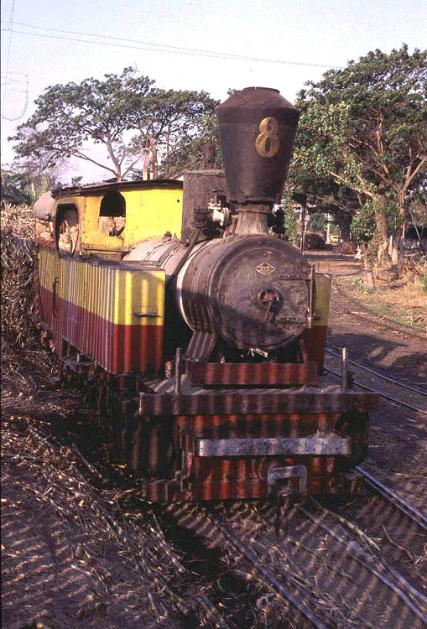
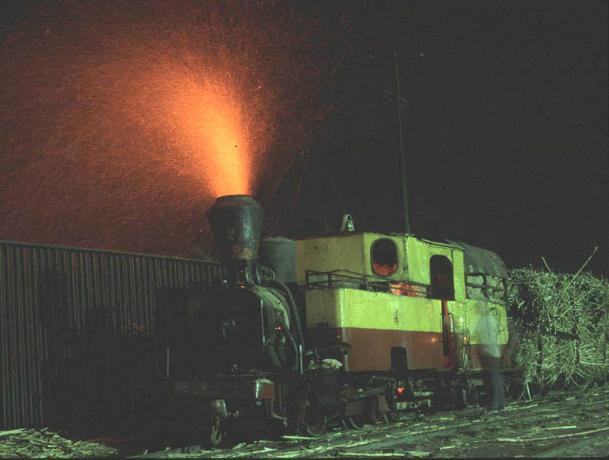
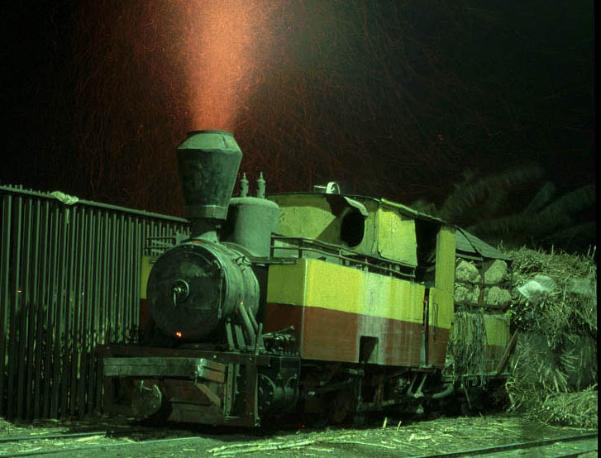
| Orenstein and Koppel No.4 is a sister engine to No.6 and is thus another centenarian, also being built in 1901. This engine had been in this position for over two hours as a result of the congestion in the main mill yard and I had to locate the crew in order to get the blower switched on and sparks to fly (left) Note the ghosting effect as one of the crew came up to the footplate during the lengthy time exposure - an occupational hazzard of this kind of photography in a working environment |
| A second Orenstein and Koppel was also waiting in the road delivery yard. Orenstein and Koppel 0-4-2T No.5 is slightly younger than here two sister engines, not having been built until 1923. The bagasse trailer appears to be loaded to the very roof |
| Taking photographs at night is something of an inaccurate science and the number of failed shots far outweigh the successful ones - at least in my case! A sturdy tripod is the first and most important requirement closely followed by the need for a small torch - in reality there is far less light than there appears to be in the photographs. There was a small amount of light from a few distant yard lamps but not really sufficient to illuminate the engines so I opened the shutter on my film camera and then used the flash on my digital camera to provide additional illumination. Time exposures varied from 15 to 60 seconds with differing amounts of fill in flash. Given all of the above its easy to see why It is almost impossible to successfully take night shots with a group of people unless tight discipline is maintained. |
| Gempolkerep (31) This 700mm gauge mill is located on the outskirts of Mojokerto. As with so many other mills the steam operation is limited to bringing wagons from the road delivery yard to the mill but the final part of the operation is particularly interesting. Locomotives are connected to the train of loaded wagons by a long steel hawser. As the train approaches the mill it takes one track and the points are changed between the engine passing and the wagons arriving! This means that the wagons take a parallel road to the locomotive which can then be released to return to the main yard. Just what would happen if one of the hawsers snapped whilst under tension is perhaps best left to the imagination. Gempolkerep is also home to a pair of Orenstein and Koppel 0-10-0 Luttermollers but unfortunately on the day of my visit one of them was undergoing a boiler washout. |

| Orenstein and Koppel 0-8-0T No.11 was in charge of the road delivery yard which can be seen in the backround. The large balloon smokestack sets off the engine in a most pleasing fashion. (24 August 2004) |
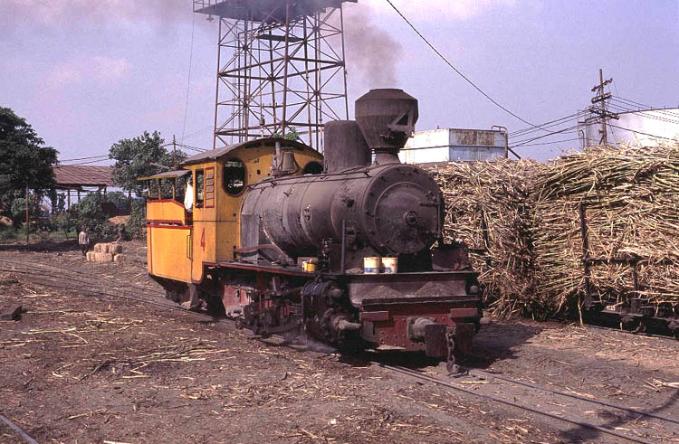
| Meanwhile in the main yard it was Orenstein and Koppel 0-10-0 No.4 (built 1928) which was the star attraction. I had always been wary of some of the liveries worn by Javanese locomotives but the combination of yellow cab and plain boiler makes this engine look most attractive. |
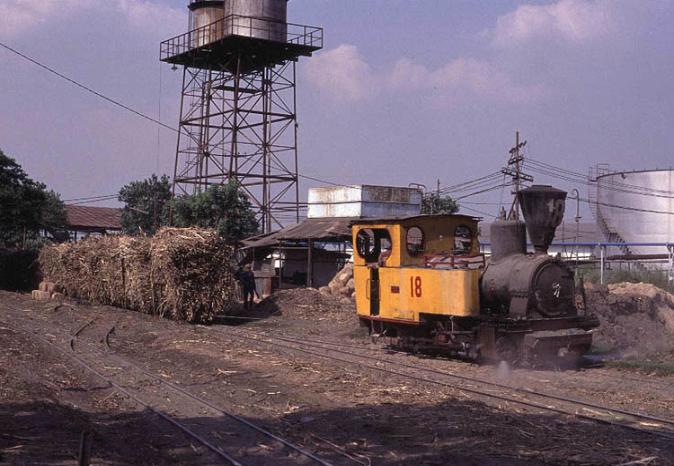
| Also in the main yard was Orenstein and Koppel 0-8-0T No.18 (built 1923) The method of working using the steel hawser can be clearly seen in the picture. The locomotive will continue down its track but the wagons will continue down the line to the left of the engine. |
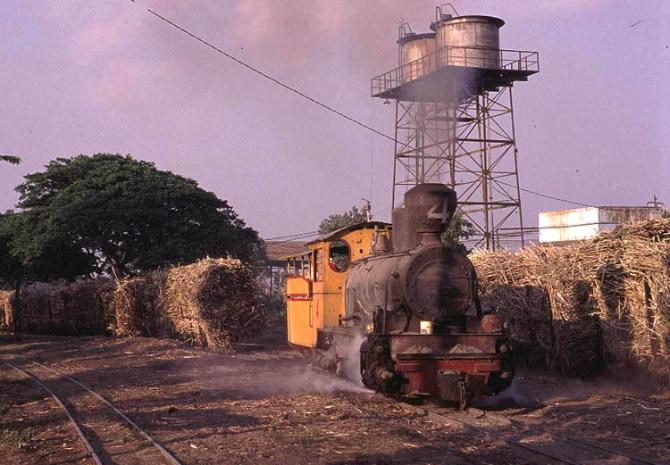
| With the sun gradually sinking into the west, No.4 comes through the main yard with another train in tow |
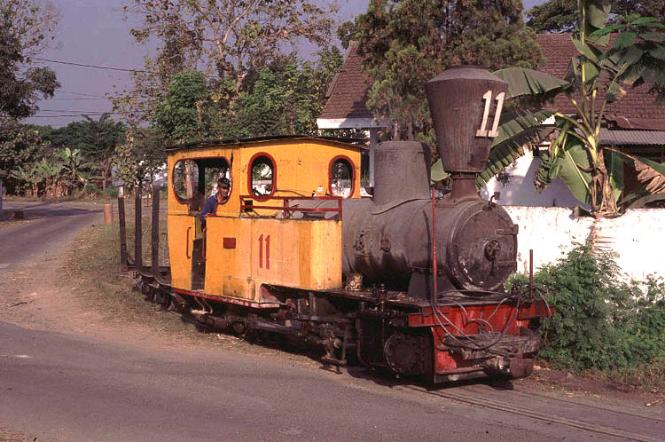
| Orenstein and Koppel No.11 catches the low afternoon light as it shunts a single empty wagon at the western end of the road delivery yard.. This was actually the last afternoon of my visit to Java and Gempolkerep certainly left me with some golden memories in every sense. |
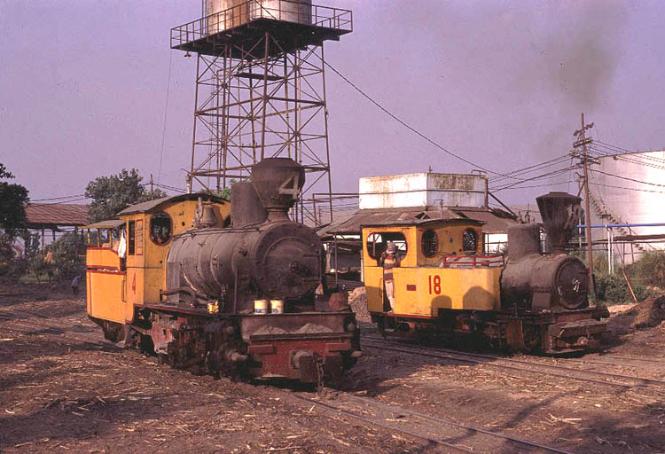
| Orenstein and Koppel Nos 4 and 11 stand side by side in the main delivery yard. I don't like interfering with the workings of a 'real' railway but have to confess to having persuaded the crews to pose the locomotives for this final shot at Gempolkerep |
| USE THE BUTTONS BELOW TO EXPLORE THE REST OF THIS SITE |